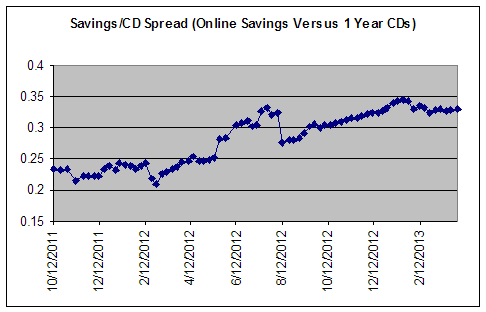This week brings more bad news for savers. Savings rates continued their relentless march, like zombies in some horror movie, moving mindlessly lower and lower. Average one-year CD Rates dipped from 0.368% to 0.366% APY. Three year average CD rates dropped from 0.730% to 0.726% APY. Five year average CDs dropped to from 1.071% to 1.066% APY. The only good news on the savings front is that average online savings rates remained steady at 0.705% APY for the second week in a row. We remain on pace to see a sub 1% average APY on a 5 year CD rate by August or September.
Last week we saw drops in the top nationally available CD rates for the 3 year and the 5 year term.
- Online Savings: AmTrust Direct retained the top spot at 1.05% APY.
- 1 Year CD: Three banks retain the top spot at 1.05% APY.
- 3 Year CD: Navy Federal Credit Union, CIT Bank , Nationwide Bank and Navy all offer a 1.35% APY with minimum balances of $100,000. Barclays Bank Delaware offers the same rate with a $0 minimum.
- 5 Year CD: Barclays Bank Delaware, CIT Bank and Nationwide Bank all offer 1.75% APY.
- Rewards Checking: Hope Credit Union and Money One Federal Credit Union both have the top rewards checking rate of 3.01% APY for balances up to $10,000. Both credit unions are open to members from across the country.
Local banks and credit unions often offer better rates (especially for CDs). For example, Share Plus Federal Savings Bank is offering a 2% APY 12-month CD. While it was initially available nationwide, it can now only be opened via the branch. Share Plus has branches in Texas, Kentucky, and California.
Check local CD rates in your area.
The chart below shows the trend in average rates since October 2012.

The difference in the rate of decline between online savings and CD rates can be viewed on the chart below, which shows the spread between online savings account rates and 12 month CDs. On average, online savings account rates pay 0.339 percentage points more than 1 year CDs, up from 0.23 percentage points more at the beginning of last year but down from the spread's high of 0.344 percentage points in late January.

Mortgage Rates
Mortgage rates, after rising for the last several months, dropped in the past few weeks. I've noticed individual banks lowering their mortgage rates by 25 to 50 percentage points. Savers' pain is borrowers gain. Rates came down because of signs that the economy was slowing and continued Fed efforts to push down long term rates. Strong employment numbers may help firm up mortgage rates going forward so buyers may be wise to lock in rates if they are planning to buy or refinance.

General rate environment
The economy had been looking soft, the Fed agreed to continue buying $85 billion per month in Treasuries to prop up the market, and then bam, the employment numbers come out. And they were pretty strong. Payrolls rose by 165,000, above most estimtes, and the unemployment rate fell to 7.5%. We are now just 1% above the number the Fed has given (6.5%) for when it will begin to ease monetary policy. In addition, last week the Labor Department reported that jobless claims fell by 18,000 to 324,000 in the week ended April 27, the lowest number in five years. Last week, we reported that housing was doing better. This week is good news on the jobless numbers.
I hurt my back three weeks ago and am working to get it better. But for every two steps forward I take, I take one step back. I feel better, go out, get more active, and then wham, I feel the pain and the muscle spasm. The central problem has still not healed. I think our economy is much the same way. We are slowly recovering, but for every piece couple of pieces of good news, there will still be bad. The fundamental problems with the economy are still there and while they may be healing, they still aren't completely better.
I have been advised that my back will get better, it just takes time. That's probably the same prognosis for the economy. Interestingly, no Dr. can tell me exactly how long it will take to feel completely better.
My outlook: Savings rates will continue to drift lower for the next 8-14 months before beginning to move higher. How high and how fast they move will depend on the level of local, state, and federal taxes and cuts; the continuation of a recent economic uptick; technological advances; and the ability of Europe to put its woes behind it and resolve its fiscal problems.
Savings Accounts or CDs?
The data continues to show that opening a savings account is a better bet than a 1-3 year term CD and I expect this to hold through 2013. Online savings accounts have held the line over the past year while CD rates continue to fall. As the chart shows, the premium for opening a longer-term CD has eroded significantly and continuously over the past year. While the premium for opening a 5 year CD over a 1 year CD was 1 percentage point in October 2011, it now stands at .703 percentage points.
Is it worth it to go long and open a 5 year? If you don't need the money, it's probably okay. Rates may begin to rise in the next year but they probably won't shoot up. Inflation looks to remain tame. There is also the chance that we go Japanese and rates continue to decline, bottom out, and stay low for the next 5-10 years. In that case, a 5-year CD today would look good. I don't expect that to happen, but it could.
For money you want to keep liquid, go with online savings accounts. They offer better rates than 1-3 year CDs and athough several banks have dropped rates in the past month, they have still offered decent rate stability over the past year and a half.
If you want to take advantage of the higher rates on longer-term CDs, look to open them at local community banks. BestCashCow research has shown that community banks and credit unions offer the most competitive rates on longer-maturity CDs. Otherwise, you'd be better off keeping your money liquid in an online savings account.
I believe this is the best and easiest strategy for keeping your cash liquid and maximizing your savings over the next year.

Make the best of a tough savings situation in 2013
Yields may be low in 2013 but a savvy saver can boost the return with no increase in rate by rate shopping. By shopping around, a saver can earn an extra half to full percentage point. On $100,000, that's $1,000 in extra cash per year. Remember, even in today's environment, there is competition for your cash.
Get Our Weekly Rate Update E-mail Newsletter
If you haven't already, sign up for the BestCashCow Weekly Rate Update Newsletter and get the best rates from your state or from around the country delivered right to your email box. It's free and takes 30 seconds to do. Sign up.













Comments
Shorebreak
May 07, 2013
I hope your back gets better soon Sol. I'm going through the similar back pain and it's not fun to say the least. I'm told "be patient it will get better". Yeah right. Thanks for your update.
Is this review helpful? Yes:1 / No: 0
Sol
May 08, 2013
Thanks Shorebank. It's been a rough couple of weeks.
Is this review helpful? Yes:2 / No: 0
Add your Comment
or use your BestCashCow account